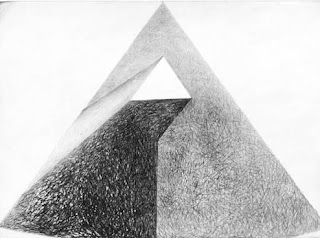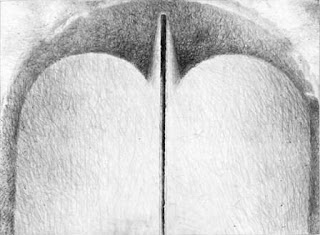The other day I was having a tutorial with students and one of them proposed application of stained glass in her project. She was introducing me to some illustrations representing works of art made of glass, when I noticed an absolutely stunning piece from Uměleckoprůmyslové museum in Prague. Though I visited Czech Republic couple of times and once even for art practice with group mates from Ural State Academy of Architecture and Arts, I have never been to the mentioned museum. You can have a look at the website here.
After doing a research it was exciting to realise how many techniques and their mixtures are applied in creating glass objects, nevertheless the one that took my attention included the process of casting. I enjoyed the works by Jan Exar, Frantisek Vizner, Gizela Sabokova and others. I was enchanted by spacious coloured glass objects transcending the light.
| Jan Exnar Original Image Here |
Looking at CV's of some authors I realised that they were in the class at Academy of Applied Arts in Prague, atelier of Professor Stanislav Libenský (e.g. Gizela Sabokova). My interest went into studying works by him and his partner Jaroslava Brychtová.
 |
| Gizela Sabokova Original Image Here |
 |
| Gizela Sabokova Original Image Here |
I wish I could see Libensky's and Brychtová's works live, but even on photographs they expose themselves to a viewer as something capturing and seductive. While having a spacious mass (some of them are about human size) they seem like if light obtains colour and by this their substance is formed.
 |
| Libensky & Brychtova, Green Eye of the Pyramid, 1922-23 Original Image Here |
I believe there is something illusionistic in their works what one might find in holographic works from 70-ies, and this evolving phantasmic dimension is filled with colour. It appears here originated from the engagement of light and glass mass. Nevertheless, the works do seem to me like light paintings in space, glass loses the matter and becomes a coloured light drawing floating in the space of those white galleries. Here the difference in thickness of glass and thus different translucency levels allow the medium to engage with and so reveal the full power of light and its way through the dimensions. Here the new value of these objects is born.
 |
| Libensky & Brychtova, Arcus Original Image Here |
 |
| Libensky & Brychtova, Arcus I, 1990-99 Original Image Here |
Here light becomes a medium which evokes new possibilities of the material it engages with. I do believe though that the strength of these works comes from a number of years of experimentation and practical learning of the technique.
 |
| Stanislav Libensky with Red Pyramid Original Image Here |
I enjoyed looking at his drawings as well. Seems like they explore more the journey of light rather than mass or composition.
 |
| Libensky, Triangle in the Triangle, 1996 Original Image Here |
 |
| Libensky, Impress of an Angel, 1996 Original Image Here |
Seems to me that there is always a number of particular techniques working with every medium, e.g. glass casting used for creating these sculptures. Nevertheless, constant technique development and experiments lead to particular unconventionality even in works made of such an ancient material as glass. Moreover, this engagement with the work brings significant progress and development of the narrative.
I hope one day I'll have an opportunity to experience those works in museum or a gallery space and of course I don't forget about my small dream to explore glass as a medium.








